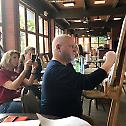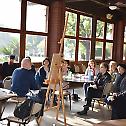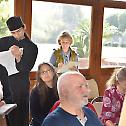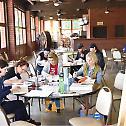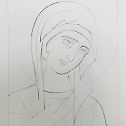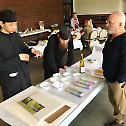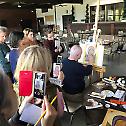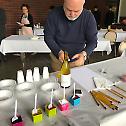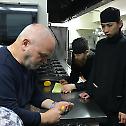Painting the Face of the Theotokos in Los Angeles with George Kordis
All those who participated in this year’s memorable iconography workshop, organized by Sebastian Press of the Western American Diocese from March 12 to 15, were deeply moved by the experience.
Ten students from USA and Canada—beginners and experienced alike—had a rare opportunity to explore the meaning and purpose of the icon with one of the world’s top iconographers. Master iconographer Dr. George Kordis from Greece introduced the student to the theory and practice of the art of icon painting, according to the Byzantine tradition. The main goal of this workshop was for students to acquire, develop, and improve good, practical, and artistic icon-drawing and painting skills while gaining a deeper sense of the art, beauty, and meaning of icons. Dr. Kordis taught the specific skills of the Byzantine approach through in-depth demonstrations and detailed exercises in the art, expression, and language of the icon, from beginning to end with his limited palette technique.
Students attended the entire process and attempted to follow making an icon—the icon subject for the workshop was the head of the Theotokos—during the five sessions course. Prof. Kordis initiated participants into the traditional process of painting an icon with the use of the egg tempera technique, with a very limited color palette. Along with teaching the importance of good freehand drawing skills (the critical basis of all contemporary Byzantine icon-painting), Dr. Kordis shared an invaluable window into the unique, artistic and spiritual process of creating a limited-palette icon.
The class met daily from 9:00 am to 4 pm, with a one-hour lunch break, 12 to 1 pm, at St. Steven's Serbian Orthodox Cathedral in Alhambra, CA. More specifically, the schedule was as follows. Session 1 had an introduction to the ideals and principles of Byzantine iconography, Byzantine painting as a system, drawing of the head of the Theotokos. Session 2 included the first steps: the background, the proplasmos, the clothes. At sessions 3 and 4 artist George Kordis gave a fascinating demonstration of his icon painting process by applying flesh tones. The last session 5 lead to last details and, finally, lettering. Along with the daily hands-on sessions, there were discussions on students questions, brief lectures, and other visual inspiration addressing iconography, icon history, and theology.
During this 5-day workshop, the students were captivated by Kordis’ bringing figure to life. They saw both the continuity and creativity in iconography as a living and creative language, learning the skills of traditional iconographic painting using the principles and rhythm of the Byzantine system as a strong foundation for creating beautiful Christian icons.
Born in Greece in 1956, Dr. George Kordis studied theology at the University of Athens, and later pursued his studies in theology and the aesthetics of Byzantine painting at Holy Cross Greek Orthodox School of Theology in Boston, gaining an MA in theology. In 1991 he was awarded his Doctorate in Theology at the University of Athens, where he was appointed to the post of Lecturer and served as assistant professor in Iconography. In addition to his academic work, Dr. Kordis periodically lectures as visiting professor and teaches icon painting courses in the US (Yale University, St. Vladimir’s Seminary, among others). His book, “Icon as Communion: The Ideals and Compositional Principles of Icon Painting,” is highly regarded as one of the only practical guides available today for learning iconographic drawing. In addition to painting portable icons, Dr. Kordis has painted many churches throughout the world, and many more recently in the U.S. Currently, Dr. Kordis is working on creating the International Centre of Iconography in Athens due to open Fall 2018, which will feature both icon exhibitions as well as rigorous education in contemporary iconography.
Source: Western American Diocese of the Serbian Orthodox Church

